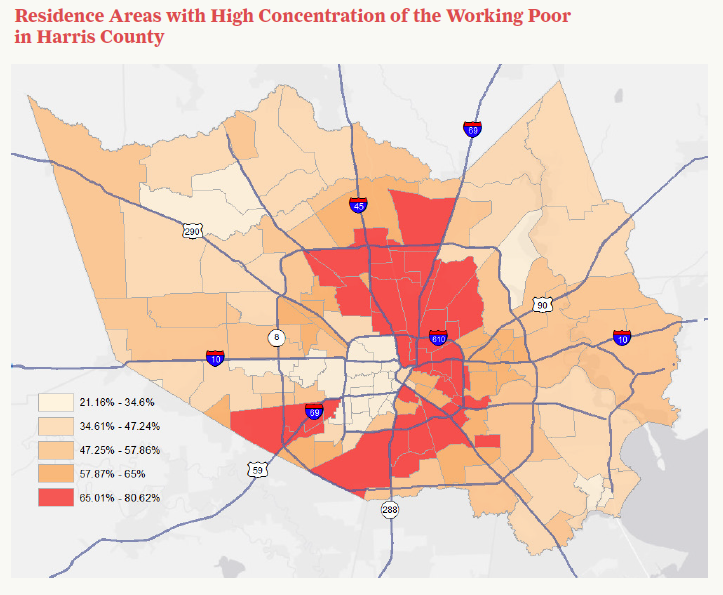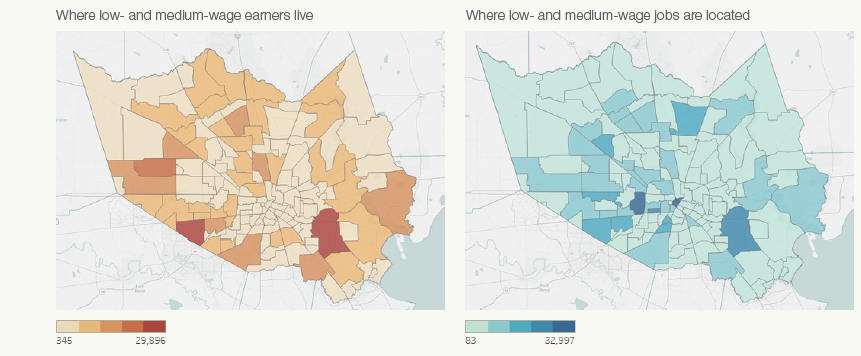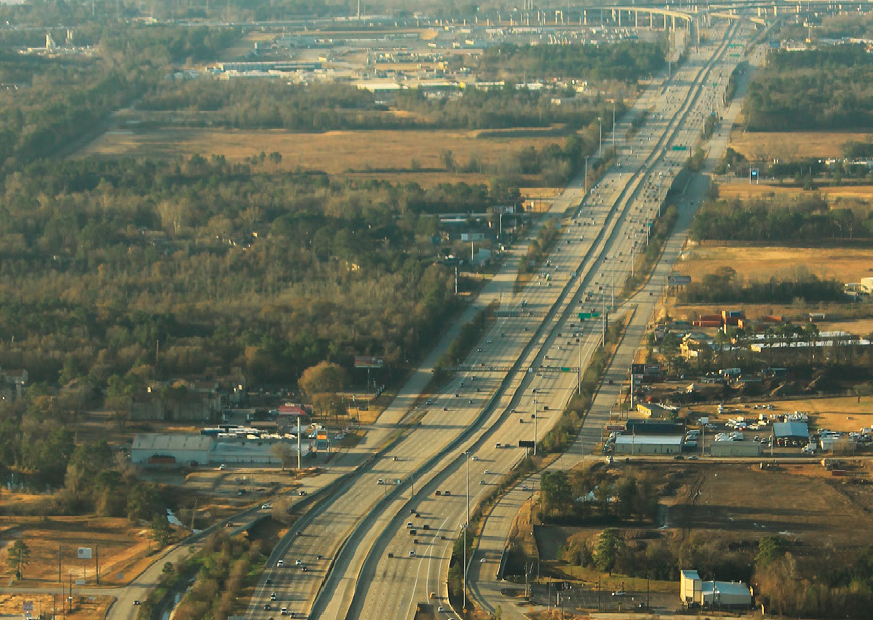Houston is often described as a multi-nodal city, with several job centers in addition to the city's traditional, central downtown. But that spread out geography doesn't necessarily mean equal access to jobs for residents across the region.
A new study from the Kinder Institute on area commuter patterns found that "generally speaking, wealthy neighborhoods located in the central city have more job opportunities," and even affluent, suburban neighborhoods were better connected to job centers through public transportation services than economically disadvantaged neighborhoods.
Most of the jobs in the Houston region are concentrated in Harris County. Living near job centers like Downtown, the Texas Medical Center or Uptown tends to be expensive. While higher earners live in concentrated areas in the county, workers earning lower wages are more scattered throughout Harris County and tend to be poorly connected to job centers via transit.

Source: Kinder Institute.
Transportation costs are a significant but often underplayed factor for households in supposedly affordable Houston. In fact, only 1 percent of census tracts in Harris County are considered "location efficient neighborhoods," close to both jobs and services with a variety of transportation choices. "When housing and transportation burdens are both considered," the report, which includes an interactive online tool, notes, "Houston is not very affordable compared to other cities."
For workers without access to a vehicle or reliable access to a vehicle, having few or no alternative transit options isn't just an inconvenience. It can actually determine employment opportunities.
A San Diego study found, for example, that even the area that had the fewest number of jobs available within a 30-minute car commute still had more jobs opportunities than the area with the greatest number of jobs within a 30-minute transit ride. That study concluded that first- and last-mile connections proved to be significant barriers for job access for workers using public transit. Strengthening the transit network could improve the spatial mismatch between workers and jobs that puts a particular burden on people reliant on public transit.
Another study out of Washington, D.C. found that job applicants who listed home addresses far away from the potential job received fewer callbacks. "Since poor minority applicants tend to live farther from jobs," wrote the study's author, David Phillips, a research associate professor in economics at the University of Notre Dame, "policies with a spatial focus will matter for employment disparities."
To examine spatial mismatch in the Houston area, Kinder Institute researchers zoomed in on three major job centers - Downtown, TMC, and Uptown/Galleria area - and three residential areas - Alief, Pasadena and Kingwood - to compare commuting patterns by wage level.

Source: Kinder Institute.
Some 2 million workers commute into Harris County every day, according to the study, which looked at 2014 Longitudinal Employer-Household Dynamics data alongside the American Community Survey. Those workers are more likely to be considered high-wage earners within the Longitudinal Employer-Household Dynamics data, meaning they make roughly $40,000 or more annually, compared to workers living in Harris County.
Though the average commute for residents in Harris County is approximately 28 minutes, that figure hides significant variation depending on where you live, household income and transit options.
So while the typical commute to the Texas Medical Center for a high-wage earner is 12.5 miles, it's 13.4 miles for the typical low-wage earner. It's worth noting that workers who are considered low-wage earners with the LEHD data are actually earning very low wages: roughly $15,000 annually. Medium-wage workers, meanwhile, are those earning between $15,000 and $40,000 annually. The median full-time yearly earning for the metropolitan area in 2014, on the other hand, was $40,100 for women and $50,501 for men.
The median income for renters was even lower in Harris County. Roughly one-fifth of renter households earn less than $15,000 and nearly a third earn between $15,000 and $34,999, according to the report. Most Harris County renters live in multi-family buildings, which tend to be concentrated on the southwest side, including neighborhoods like Gulfton. In other metropolitan areas, renters tend to have shorter commutes than homeowners. But "that’s not the case for low-wage workers in Houston. Few affordable units are found in major job centers, making it difficult for low-wage workers to live close to where they work." Within the various draft plans presented as part of Metro's recent, still-in-the-works long-term vision, proposed bus rapid transit routes included a link between Gulfton and the Uptown Transit Center.
The study also compares commuter outcomes for three different neighborhoods: Alief, Pasadena and Kingwood. Also on the southwest side, Alief is a diverse neighborhood, roughly 45 percent Hispanic, 24 percent black, 22 percent Asian and 8 percent white. More than half of the households earn less than $40,000 annually. Most commuters drive alone and only 4 percent use public transit. On a typical workday, according to the report, it takes between 30 and 50 minutes to get to downtown from Alief by car but can take almost an hour and a half by transit with multiple transfers.
Pasadena is similar socioeconomically to Alief, though about 67 percent of residents there are Hispanic and 28 percent are white, and it's closer to Houston's city center. A commute to downtown by car takes between 20 and 40 minutes. Some 7 percent of households in Pasadena don't have access to a vehicle, according to the report, but certain areas of the city have higher rates. Because the community opted out of service by Metro and ended other local public transportation options, the large majority of workers commute by car alone or carpool. It's worth noting that suhc service provision decisions, like those to end or opt out of transit, occured in a city that "has a long history of discrimination against minorities, including Latinos," according to a 2017 ruling by U.S. District Court Judge Lee Rosenthal that found that the city's 2014 redistricting was deliberately meant to dilute the power of Latino voters in a long-divided city. Later that year, the newly elected mayor promised to revive local transit service in the area but those plans have stalled.
Compare that to Kingwood, an overwhelmingly white suburban neighborhood north of town where the vast majority of workers are considered high-wage earners. The commute mode breakdown is similar to Alief, with just 4 percent using public transit and most workers driving alone to work. More than 10 miles farther from downtown than Alief, Kingwood has slightly longer car commutes but significantly faster transit commutes. A weekday commuter service from the area park and ride takes about 55 minutes, according to the report.
Strengthening transit, providing more affordable housing near job centers and other interventions can help address some of these imbalances. "Houston is fortunate to have several strong and important job centers that provide many employment opportunities for lower-wage workers," the report concludes. "But the future economic well-being of the city and the region depend a great deal on the ability of policymakers to address the spatial mismatch so that workers can get to their jobs and businesses can count on a reliable workforce."

